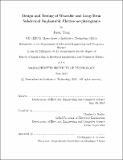| dc.contributor.advisor | Charles G. Sodini. | en_US |
| dc.contributor.author | Yang, Jason, M. Eng. Massachusetts Institute of Technology | en_US |
| dc.contributor.other | Massachusetts Institute of Technology. Department of Electrical Engineering and Computer Science. | en_US |
| dc.date.accessioned | 2018-02-08T15:58:28Z | |
| dc.date.available | 2018-02-08T15:58:28Z | |
| dc.date.copyright | 2017 | en_US |
| dc.date.issued | 2017 | en_US |
| dc.identifier.uri | http://hdl.handle.net/1721.1/113456 | |
| dc.description | Thesis: M. Eng., Massachusetts Institute of Technology, Department of Electrical Engineering and Computer Science, 2017. | en_US |
| dc.description | This electronic version was submitted by the student author. The certified thesis is available in the Institute Archives and Special Collections. | en_US |
| dc.description | Cataloged from student-submitted PDF version of thesis. | en_US |
| dc.description | Includes bibliographical references (pages 115-116). | en_US |
| dc.description.abstract | Electroencephalography (EEG) has long been used by neurologists to aid in diagnosing and treating neurological disorders ranging from sleep apnea to epilepsy. However, inherent difficulties still exist in capturing EEG data for extended periods of time on the order of days to weeks in humans. Such difficulties brought on by implementation challenges and usability ultimately lead to patient non-compliance. These challenges also curtail EEG use in sleep studies due to complexity of setup. This work aims to address these issues by extending the functionality and performance of a previously designed EEG ASIC. A design for a subdermal, implantable EEG recording system for long term EEG monitoring as well as a simplified wearable and wireless EEG sensor is realized. The implantable design is an 8-channel, 250Hz bandwidth EEG system in a 14.0mm x 15.5mm package that is wirelessly powered by an external device through inductively coupled coils with backscattering. The device is placed subdermally above the skull for continuous patient EEG monitoring for up to a month to aid neurologists with epilepsy diagnosis. This device is especially important given the severity of antiepileptic drugs' side-effects. The performance of this device is verified through animal studies in pigs. This work is also extended to the design of a wearable, wireless EEG patch for sleep studies. The device is a 20mm x 24mm, 4-channel, 250Hz bandwidth, Bluetooth Low-Energy (BTLE) electronics package with adhesive electrodes that can be quickly applied. This device is aimed to assist neurologists and clinicians perform sleep studies. Results are verified using sleep data collected on the author. | en_US |
| dc.description.statementofresponsibility | by Jason Yang. | en_US |
| dc.format.extent | 116 pages | en_US |
| dc.language.iso | eng | en_US |
| dc.publisher | Massachusetts Institute of Technology | en_US |
| dc.rights | MIT theses are protected by copyright. They may be viewed, downloaded, or printed from this source but further reproduction or distribution in any format is prohibited without written permission. | en_US |
| dc.rights.uri | http://dspace.mit.edu/handle/1721.1/7582 | en_US |
| dc.subject | Electrical Engineering and Computer Science. | en_US |
| dc.title | Design and testing of wearable and long-term subdermal implantable electroencephalograms | en_US |
| dc.type | Thesis | en_US |
| dc.description.degree | M. Eng. | en_US |
| dc.contributor.department | Massachusetts Institute of Technology. Department of Electrical Engineering and Computer Science | |
| dc.identifier.oclc | 1020180344 | en_US |
